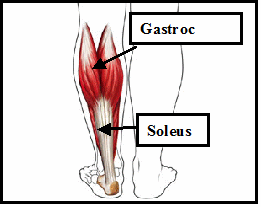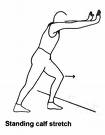![]()
2 – CALVES & CALF KNOTS: The DO’s & DON’Ts of Happy Runner Calves
![]()
As coaches of runners of all abilities, shapes and sizes for the past decade plus, and based upon our own shared experience as competitive road racers and long distance runners, the team at Marathon Dynamics can now confirm that one of the all-time top 2 or 3 running injury issues these days are calf problems--pulls, strains, tugs, tears, etc. Every season there always seem to be a few unlucky souls training with Marathon Dynamics (sometimes it’s us!) who’s grand running dreams/goals are cut short by a sudden shock of pain somewhere between (and/or including) their Achilles tendon and the back of their knee.
Whether you “blow a gastroc” (gastrocnemius—upper/larger calf muscle, see diagram below in red) or strain a soleus (lower/smaller calf muscle, see diagram below in grey), depending on the severity of the injury and how you chose to deal with it, it can really “cramp” your running style—for weeks or even months at a stretch!

There’s lots of information out there—in books, in clinics, and online—about the definitions, causes, symptoms, diagnoses and treatment of calf injuries. For more specific/detailed info on those aspects, please visit the website: http://sportsmedicine.about.com
However, there seems to be sparingly little attention paid to PREVENTION of calf problems in the first place. That is what we want to highlight here.
Some of the most important risk factors that can increase the chance/severity of calf muscle strains or pulls are:
Sports that require bursts of speed like running, soccer, basketball, etc.
Fatigue
Dehydration
Overexertion
Cold weather
So with those factors in mind, here are our Top 5 Tips For Happy, Healthy Calves:
Drink Water & Replace Electrolytes: we need to ensure we are well hydrated--not just while running, but also throughout the day, to ensure high blood volume and low blood viscosity, so that our working muscles have adequate circulation of blood supply to prevent cramping. We need electrolytes (sodium/potassium) to enhance fluid retention, and to carry the electrical impulses for muscle contractions and nerve impulses from brain to working muscles. Keep that Gatorade & bottled water flowing!
Strengthen Calves Regularly: though “formal” gym/weights leg workouts are certainly a great adjunct to training when done properly, we’re not even talking about that here. We’ve found that simply establishing a regular routine (2 times per week minimum, 3-4 times per week maximum) of 2-3 sets of “bodyweight only” (i.e. no extra barbells) “ground level” heel raises (i.e. no need to use the edge of stairs/steps, though that is a more potent, aggressive option with higher risk of Achilles strain), with high repetitions as the focus (at least 15-20 to start, building up to 30-40 per set, per leg), we reduce the incidence/severity of running calf injuries. I myself have found that when I do these (regularly), I don’t get calf injuries…when I don’t do them, I do.
* Note: for added effectiveness/variety, experiment with inverting and everting your toe direction (as well as straight ahead) as you perform the heel raises, to target the medial and lateral aspects of your calves.
S
 tretch
Gently & Regularly…Both
Calf Muscles of Both Legs:
create
a very simple and quick “pre and post” run routine of
gently (to point of mild sensation, NOT PAIN) and progressively
(start with 5-10 seconds on first rep, lengthen to 15-20 seconds
next/last rep) stretching BOTH the gastroc and the soleus of EACH
leg--at least 1 rep, ideally 2, max 3 of each stretch—before
you start key run workouts Intensity W/Os, OMPs, Racepaces, etc.)
and/or when you finish them too (The gastroc is best stretched in a
straight back leg position, the soleus in a bent back leg position
(see diagrams below):
tretch
Gently & Regularly…Both
Calf Muscles of Both Legs:
create
a very simple and quick “pre and post” run routine of
gently (to point of mild sensation, NOT PAIN) and progressively
(start with 5-10 seconds on first rep, lengthen to 15-20 seconds
next/last rep) stretching BOTH the gastroc and the soleus of EACH
leg--at least 1 rep, ideally 2, max 3 of each stretch—before
you start key run workouts Intensity W/Os, OMPs, Racepaces, etc.)
and/or when you finish them too (The gastroc is best stretched in a
straight back leg position, the soleus in a bent back leg position
(see diagrams below):
Do Late Run or Post Run Striders: build “striders” into the last 5-8 minutes of your “regular” runs throughout the week (like OMP, Recovery, LSDs) or if you prefer, do them shortly after you finish. What are striders? Glad you asked! They are gradual, running form-conscious, smooth & controlled accelerations of about 100m or so (never sprinting!), where you work on quicker strides, higher knees, upright & relaxed upper body posture, effective but efficient arm swing, etc. You can start with just 1 or 2 the first few times you try these, and build up to where you are doing 4 or 5 in during the last mile or so of most runs. Note: do not try these if/when you are already experiencing calf tightness (or for that matter tightness or near-injury state anywhere in the body). When these are done regularly, properly and healthily, they help to injury proof the legs, especially the ankle lever (which is comprised of the plantar fascia, the Achilles tendon and the calf muscles) by habituating that biomechanical chain to the higher loads of fast running without the prolonged stress of true speed work.
Get a good night’s sleep AFTER hard run workouts: it is only during rest that we can reap the hard earned rewards of strong/fast/long runs…and sleeping is about the highest yield form of rest, so do everything you can to make it happen. There are usually only 2 or 3 of these per week, so as long as you plan ahead to try and get that extra hour of sleep (target 8!) on those nights, you will be guaranteeing the maximum restoration and rebuilding of tired, sore, broken down muscles, such as our ever-important calves!